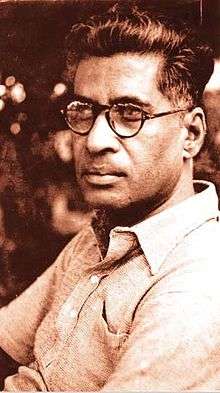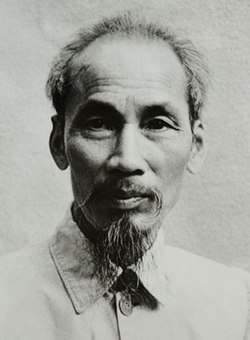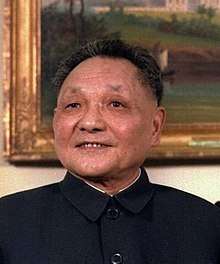Communist University of the Toilers of the East
The Communist University of the Toilers of the East (KUTV) (Russian: Коммунистический университет трудящихся Востока; also known as the Far East University) was a revolutionary training school for important Communist political leaders. The school operated under the umbrella of the Communist International and was in existence from 1921 until the late 1930s.
History




The Communist University of the Toilers of the East (KUTV) was established 21 April 1921, in Moscow by the Communist International (Comintern) as a training college for communist cadres in the colonial world. The school officially opened on 21 October 1921. It performed a similar function to the International Lenin School, which mainly accepted students from Europe and the Americas. It was headed in its initial years by Karl Radek, who was later purged from the Communist Party of the Soviet Union. The curriculum included both theoretical and practical matters, including Marxist theory, party organization and propaganda, law and administration, theory and tactics of proletarian revolution, problems of socialist construction, and trade union organization.
From Summer 1922 KUTV had regional branches in Baku (in Azerbaijan), Irkutsk (in Siberia, Russia), and Tashkent (in Uzbekistan). The University published Revolutionary East (Революционный Восток, Revoliutsionnyi Vostok). Amongst those who taught there were Ho Chi Minh, Anatoly Lunacharsky, Leonid Krasin, Mikhail Pokrovsky, Khalid Bakdash, Igor Reisner, and Boris Shumyatsky.
In 1928 the Japanese Foreign Ministry estimated that some 1,000 foreign students studied at KUTV, and that 400 Chinese students comprised the largest group, followed by 350 ethnic minorities within the Soviet Union, and between 30 and 40 Japanese. The Soviet Union solicited working-class Japanese to study at the KUTV without the Japanese government's consent. The Japanese students studied under Takahashi Sadaki and Yamamoto Keizo, along with several Russian instructors. The Japanese students studied economics, the history of world revolution, Leninism, philosophy, labor union theory, and Japanese studies. Tokuda Kyuichi, a member of the Japanese Communist Party, was instrumental in recruiting and sending these Japanese workers to KUTV via Shanghai and Vladivostok.[1]
KUTV was closed in the late 1930s. Its tasks were transferred to smaller, local institutions in the various Soviet republics.
Alumni
Prominent alumni of the KUTV include:
- Anchimaa-Toka, Khertek, chairperson of the Little Khural of Tannu-Tuva
- Bakdash, Khalid, secretary of the Syrian Communist Party from 1936 until 1995
- Chiang Ching-kuo, President of the Republic of China, 1925 class
- Deng Xiaoping, paramount leader of the People's Republic of China, 1925 class
- Ghaliev, Sultan, the Muslim National Communist
- Hà Huy Tập, third General Secretary of the Communist Party of Vietnam
- Haywood, Harry, leading African-American member of the Communist Party USA
- Jane Golden, black American student who died during her time at KUTVA [2]
- Hikmet, Nâzım, Turkish poet
- Hồ Chí Minh, President of Vietnam, 1923 class
- Israilov, Khasan, Chechen insurrectionist
- Katayama, Sen of the American and Japanese CP
- Lê Hồng Phong, second General Secretary of the Communist Party of Vietnam
- Liu Shaoqi, President of the People's Republic of China, 1921 class
- Mamakaev, Magomet, Chechen writer
- Malaka, Tan of the Indonesian CP
- Roy, Manabendra Nath, helped found the Communist parties in Mexico and India
- Sidqi Muhammad Najati, writer, activist in the Palestinian independence movement, from 1925 to 1928
- Pishevari, Ja'far, founder and chairman of communist Azerbaijan People's Government
- Toka, Salchak, Tuvan government official
- Shwala, Sbulawelani, leader of the Young Communist League of South Africa and Revolutionary writer Republic of South Africa
- Trần Phú, first General Secretary of the Communist Party of Vietnam
- Wang Fanxi, prominent Chinese Trotskyist
- Yusuf, Yusuf Salman (Fahd), secretary of the Iraqi Communist Party from 1941 to 1949
- Zachariadis, Nikolaos, General Secretary of Communist Party of Greece and chairman of Greek Communist Provisional Democratic Government, 1947 to 1949
See also
Footnotes
- ↑ Koshiro, Yukiko (May 10, 2013). Imperial Eclipse: Japan's Strategic Thinking about Continental Asia before August 1945. Cornell University Press. p. 15.
- ↑ https://books.google.com/books?id=bHc44CrYKccC&pg=PA125&lpg=PA125&dq=jane+golden+communist&source=bl&ots=ez7AnDTQ0V&sig=4qQ1iAHzAAcKstPUw58ppoMs9aU&hl=en&sa=X&ved=0ahUKEwi6tYSElc3ZAhWJt1kKHYLEBt8Q6AEIPjAC#v=onepage&q=jane%20golden%20communist&f=false
Other sources consulted
- (in Russian) Great Soviet Encyclopedia entry
- (in English) "The Political Tasks of the University of the Peoples of the East" speech by Joseph Stalin (Marxists Internet Archive)